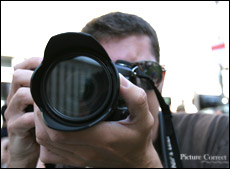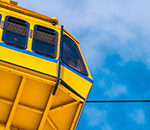When you are first buying camera equipment you see a lot of lenses that have the IS or VR designations on them. This is Image Stabilization or Vibration Reduction. They mean the same thing except Canon uses the first term and Nikon uses the second. These are mechanisms built into the camera lens to prevent “camera shake”. I will discuss how to get rid of camera shake and why I purchased a VR lens for myself.
 What is Camera Shake?
What is Camera Shake?
When you are holding your camera in your hands and looking through the view finder to take your photo, your body is making slight movements. This is a natural thing as your body is always correcting itself and your muscles move to help maintain your balance. However, it causes slight movements in your camera. When your camera is zoomed in on a subject that is a reasonable distance away, these slight movements become more noticeable.
For example. If your hand slightly shakes and turns your camera 1 degree off its line of direction and your subject is 15 feet away, this would correspond to 3.1 inches being added in the direction your camera turned. Now say that the movement of your hand happened when you took your picture and while the shutter was open. This would blur the image on film or on your digital image.
How Do I Prevent My Pictures From Blurring?
There are 3 ways to prevent this.
1. Make sure you have a shutter speed fast enough so that your hand movements don’t affect the picture.
2. Use a tripod.
3. Have a lens with vibration reduction or image stabilization.
Each of these methods have their pros and cons.
1. Have a Fast Enough Shutter Speed
Ideally, you would want this situation every time. The rule of thumb is that you need a shutter speed of 1 over the focal length your lens is set at. So if you are zoomed all the way in with your 300mm lens, you would want 1/300 second shutter speed or better (so 1/320 on the standard camera). This will usually guarantee (for the average user) the shutter won’t be open long enough to make your hand movements noticeable on the final image If you have steady hands you will be able to get away with a slower speed. The catch here is will you have enough light to expose your picture. If it is the middle of a bright day you are fine. If it is darker you might have to use a more sensitive film, but this will cause your picture to be grainier.
Note: When you see expensive lenses with the same zoom capability as a cheaper lens, look at the maximum aperture for this lens. Chances are it will be a lot larger than the cheaper one. F/2.8 is a common one. The lower the number, the larger the aperture can go. This means a lot more light will get let in when you take the picture, so it will be able to have higher shutter speeds.
 2. Use a Tri-pod
2. Use a Tri-pod
This will always work. Now you can have the shutter open as long as your want and the image won’t have any blurring (this is assuming your subject isn’t moving or is moving slowly). Tripods are cumbersome and annoying however. And they definitely don’t work in a lot of circumstances, especially traveling.
3. Use a Lens With Image Stabilization or Vibration Reduction
This is “meet in the middle” approach as you still need a decent shutter speed, but you won’t need a tripod and its cheaper than a fast lens. Inside the camera there is a mechanism to adjust the glass lenses slightly to compensate for the movements of your hand. IS and VR will give you a few shutter speed stops back. So if you can’t quite get enough light to have 1/320 sec shutter speed as in the example above. VR will let you go down to 1/125 sec (4 full stops in ideal situations). A lot of times, this will give you enough light to properly expose your image. VR and IS will make a lens cost extra, but they are still cheaper than buying the fast lenses I spoke of above. Fast lenses don’t usually have much zoom capability either (a limitation of having such a large aperture).
The main article has an example of two images. One was taken without VR turned on and the other had VR on. This is a picture in my home taken with my Nikon D70s with the Nikon 18-200mm VR lens.
To summarize. The cheapest solution is to buy a tripod, the second is to buy a lens with IS or VR, and the most expensive is to buy “fast” lenses. I am a casual photographer and use it more for traveling so VR has been the best option for myself. If you find yourself with similar needs and want to eliminate camera shake from more of your photos, then I would definitely recommend looking at VR and IS lenses.
For more articles on photography from this author, please check out www.thoughtsfrommylife.com/category-Photography.
The author maintains the site www.thoughtsfrommylife.com.
Like This Article?
Don't Miss The Next One!
Join over 100,000 photographers of all experience levels who receive our free photography tips and articles to stay current:





Leave a Reply